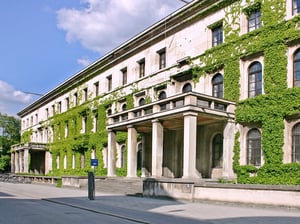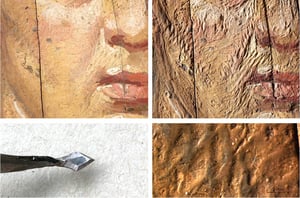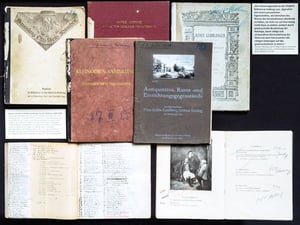The Central Collecting Point and the founding of the Zentralinstitut für Kunstgeschichte
In June 1945 the American Office of Military Government installed the Central Art Collecting Point in the former National Socialist Party buildings on Königsplatz in Munich. This art collection facility was to restitute cultural property looted by the National Socialist regime to its rightful owners. The institutionalization of this facility as well as the art historical activities carried out at the Collecting Point relied on the cooperation of allied military, government, and civilian organizations and institutions. The Monuments, Fine Arts, & Archives Section (MFA&A) was the agency of the military government responsible for the Collecting Point in the American occupation zone.
The removal of art works and cultural properties from their provisional storage locations to Munich began in June 1945. These remote storage facilities included Schloss Neuschwanstein, Kloster Buxheim, the salt mine near Altaussee and numerous other locations.
On arrival the art objects were registered and labelled with an accession number (the so-called M- or Munich number) and information about provenance, storage location, the item and its technique, as well as a short description. Restitution to the affected European countries and within Germany began in August 1945. In September 1949 the American military government turned over to the German officials the responsibility for the safekeeping and restitution of the looted artworks that still remained in the Collecting Point.
In 1948 the US Military Government established the US Information Center in the former „Führerbau“, neighbouring the Collecting Point. The exhibitions on modern and international art, mostly on non-objective painting, which were shown in the „Collecting Point Gallery“ from 1949 meant an explicit contrast to the art fostered by the nazi regime. As part of the US program of „re-education“ these exhibitions aimed at the reconstruction of a liberal and international art scene in the US occupation zone.
History of the Zentralinstitut für Kunstgeschichte. Decisively encouraged by the art historian Craig Hugh Smyth (1915-2006), the first director of the Central Collecting Point 1945-46, in November 1946 the Zentralinstitut für Kunstgeschichte was established as an internationally oriented art historical research centre.
The founding director of the institute was Ludwig Heinrich Heydenreich (1903-1978) who was supported during the initial years by Wolfgang Lotz (1912-1981), acting director of the ZI in 1946-47, along with the head of the library Otto Lehmann-Brockhaus (1909-1999).
Reassessing the CCP from today’s perspective. The publication by Iris Lauterbach on the Munich Central Collecting Point was published in 2015: „Der Central Collecting Point in München. Kunstschutz, Restitution, Neubeginn“. The book deals with the history of the Central Collecting Point as an institution, its location and foundation, its staff and activities from 1945 to 1951. Members of the Collecting Point initiated the foundation of the Zentralinstitut für Kunstgeschichte in 1946 as a research institution for art history on an international level.






